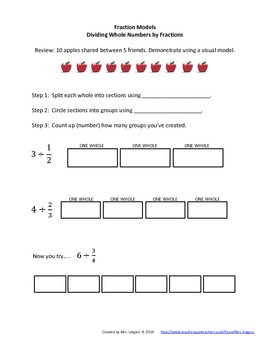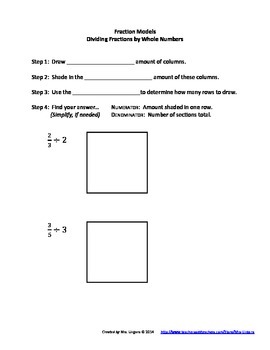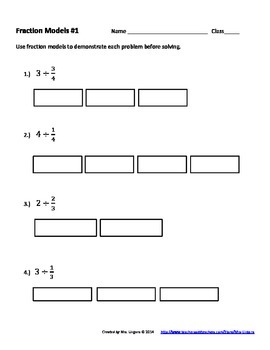Modeling Division of Fractions & Whole Numbers Unit
Mrs Ungaro
42 Followers
Grade Levels
5th - 7th
Subjects
Resource Type
Standards
CCSS5.NF.B.7a
CCSS6.NS.A.1
Formats Included
- PDF
Pages
11 (+11 answer key pgs)
Mrs Ungaro
42 Followers
Description
This unit has everything you need for modeling division of fractions in relationship to whole numbers! Much needed word problem practice of these combined methods is also included at the end.
When purchasing this unit you'll receive:
Method 1: Models of Dividing Whole Numbers by Factions
*Skeleton Notes
*Double Sided Practice Worksheet
Method 2: Models of Dividing Fractions by Whole Numbers
*Skeleton Notes
*Double Sided Practice Worksheet
Single Page Word Problem Team Practice
2 Challenging Double Sided Word Problem Worksheets
--Students must identify what the problem is asking them to solve.
--Each problem has space to show required modeling.
--The problems are written so that the order the numbers appear in
the problem are not always the order of the division problem. It
forces students to thoroughly evaluate the format of the division
problem.
Answer keys for all pages are also included!
This work is licensed under a Creative Commons Attribution-NonCommercial-NoDerivs 3.0 Unported License.
When purchasing this unit you'll receive:
Method 1: Models of Dividing Whole Numbers by Factions
*Skeleton Notes
*Double Sided Practice Worksheet
Method 2: Models of Dividing Fractions by Whole Numbers
*Skeleton Notes
*Double Sided Practice Worksheet
Single Page Word Problem Team Practice
2 Challenging Double Sided Word Problem Worksheets
--Students must identify what the problem is asking them to solve.
--Each problem has space to show required modeling.
--The problems are written so that the order the numbers appear in
the problem are not always the order of the division problem. It
forces students to thoroughly evaluate the format of the division
problem.
Answer keys for all pages are also included!
This work is licensed under a Creative Commons Attribution-NonCommercial-NoDerivs 3.0 Unported License.
Total Pages
11 (+11 answer key pgs)
Answer Key
N/A
Teaching Duration
N/A
Report this resource to TPT
Reported resources will be reviewed by our team. Report this resource to let us know if this resource violates TPT’s content guidelines.
Standards
to see state-specific standards (only available in the US).
CCSS5.NF.B.7a
Interpret division of a unit fraction by a non-zero whole number, and compute such quotients. For example, create a story context for (1/3) ÷ 4, and use a visual fraction model to show the quotient. Use the relationship between multiplication and division to explain that (1/3) ÷ 4 = 1/12 because (1/12) × 4 = 1/3.
CCSS6.NS.A.1
Interpret and compute quotients of fractions, and solve word problems involving division of fractions by fractions, e.g., by using visual fraction models and equations to represent the problem. For example, create a story context for (2/3) ÷ (3/4) and use a visual fraction model to show the quotient; use the relationship between multiplication and division to explain that (2/3) ÷ (3/4) = 8/9 because 3/4 of 8/9 is 2/3. (In general, (𝘢/𝘣) ÷ (𝘤/𝘥) = 𝘢𝘥/𝘣𝘤.) How much chocolate will each person get if 3 people share 1/2 lb of chocolate equally? How many 3/4-cup servings are in 2/3 of a cup of yogurt? How wide is a rectangular strip of land with length 3/4 mi and area 1/2 square mi?





